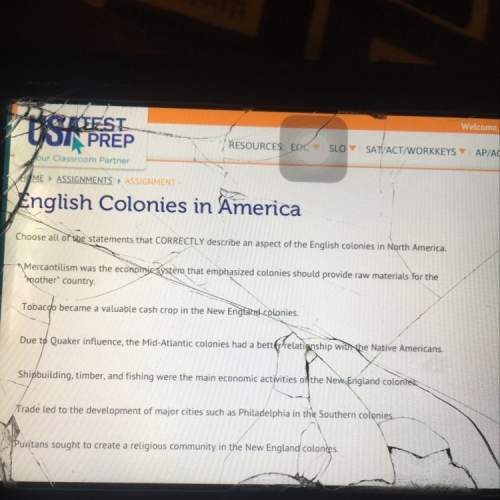

Answers: 3


Another question on History

History, 21.06.2019 15:00
One of the main problems with the indian reservation system was that government agents took land from settlers to give to american indians. dealt dishonestly with american indian families. did not understand the power structure of american indian tribes. gave land to settlers who removed american indians.
Answers: 2

History, 22.06.2019 06:40
Examine the dates in this timeline: • 1918: the ottoman empire loses control of iraq to the britishfollowing world war i.• 1932: the kingdom of iraq is granted its independence from greatbritain• 1945: mustafa barzani leads a failed rebellion against the iraqigovernment• 1948: the al-wathbah uprising results in protests against the iraqigovernment before it is violently suppressed.• 1958: the kingdom of iraq is overthrown by military leaders whoestablish the republic of iraq,• 1980: iraq invades iran, launching the iran iraq war.• 1990: iraq invades kuwait but is defeated by united nations forcesled by the united states.• 2003: the united states and its allies invade iraq and remove itsdictator, saddam hussein.which title would best suit the period in iraqi history from 1980 through1990? a. the era of political instability and protestb. the era of american involvementc. the era of iraqi aggressiond. the era of early iraqi independence
Answers: 1

History, 22.06.2019 11:00
20 points “the creation of a mosaic was a complicated procedure that called for careful timing and teamwork. . walls were painted with resin or tar before being covered with the first of three layers of plaster. . a sketch of the projected work was then made on the plaster to serve as a guide for the various artisans. the outermost layer of plaster, in which the pieces, or tesserae, of the mosaic would be set, was spread on only enough area to contain a day’s work. some of the tesserae—small, carefully cut fragments of colored glass, marble, and semiprecious stones—were pressed into the wet plaster so that they projected at a slight angle. the stones thereby better reflected light and imbued the finished mosaic with a shimmering life of its own.” —empires besieged: time frame a.d. 200–600 how many layers of materials were under the tiles? a. two- c. four- b. three- d. five
Answers: 2

History, 22.06.2019 12:00
As nation-states began to arise in europe, who became the most powerful individuals?
Answers: 1
You know the right answer?
Which Great Awakening preacher used reasonable arguments to convince
people to live in a way that a...
Questions

Physics, 30.01.2020 23:01

History, 30.01.2020 23:01

Mathematics, 30.01.2020 23:01

History, 30.01.2020 23:01

Mathematics, 30.01.2020 23:01




Mathematics, 30.01.2020 23:02


History, 30.01.2020 23:02

History, 30.01.2020 23:02


History, 30.01.2020 23:02

Physics, 30.01.2020 23:02



Mathematics, 30.01.2020 23:02





